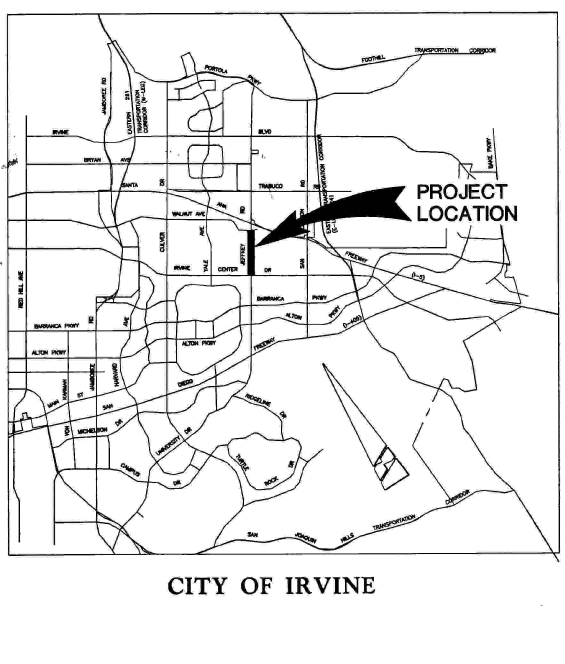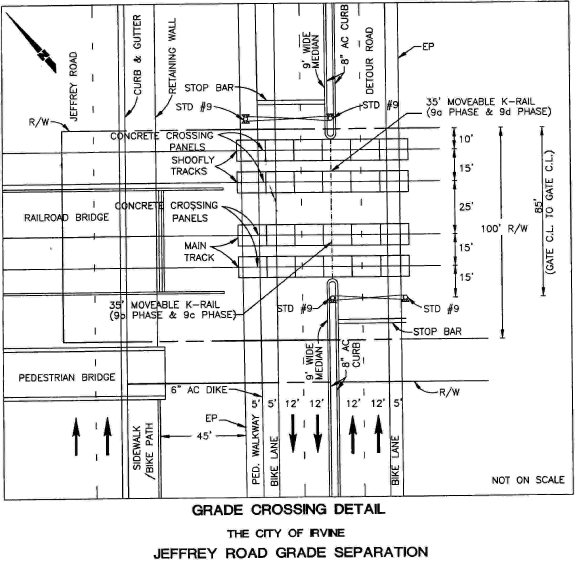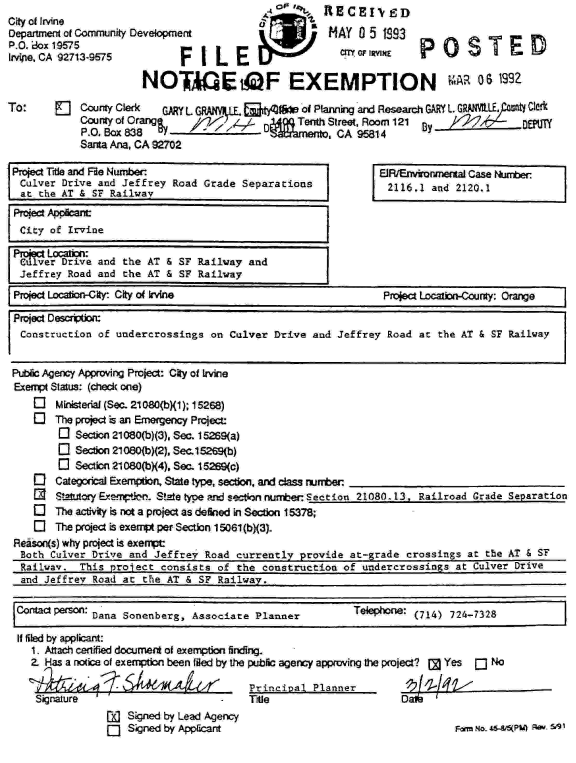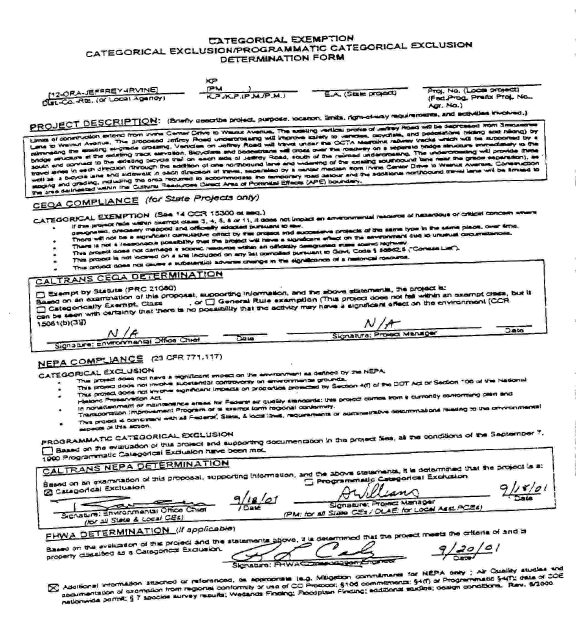Discussion
OCTA owns the right-of-way within the project limits, which were originally owned and operated by Atchison, Topeka, and Santa Fe Railway Company. Burlington Northern Santa Fe Railway Company operates freight trains and the National Railroad Passenger Corporation (Amtrak) operates passenger trains over these tracks. The Southern California Regional Rail Authority (SCRRA) is a five-county joint powers authority created by Senate Bill 1402 of 1990, under Public Utilities Code Section 130255 pursuant to Government Code Section 6501 et al., to build and operate the Metrolink commuter rail system. OCTA is one of the five SCRRA member agencies. Amtrak also operates the Metrolink trains for SCRRA, and SCRRA maintains the tracks.
The railroad tracks will cross Jeffrey Road on a bridge, and Jeffrey Road will be depressed below the railroad tracks. The grade separation of Jeffrey Road is required to completely eliminate the hazard of train vehicle collisions and motor traffic delays due to train movements.
A temporary detour road and two temporary bypass tracks will be constructed during the construction of the Jeffrey Road underpass to divert train and vehicular traffic away from the construction site. This will require the construction of a temporary at-grade highway-rail crossing on the detour road located approximately 145-feet to the east of Jeffrey Road. The at-grade highway-rail crossing at the temporary detour road will include two mainline tracks and two bypass tracks, a total of four tracks. The warning devices at the temporary detour road at-grade highway-rail crossings will consist of four Standard No. 9s (flashing light signals with automatic gates), as described in Commission General Order (GO) 75-C. Two of the Standard No. 9s will be curb-mounted and the other two will be median-mounted, as shown in Appendix B attached to this order. The project will be built in stages as detailed below.
In the first stage the bypass tracks (except within Jeffrey Road) will be constructed and the bypass tracks will be tied-in with the existing mainline tracks. The temporary detour road and the crossing of the mainline and bypass tracks with the temporary detour road will then be constructed. K-rail barricades will be placed over the bypass tracks at the temporary detour road crossing to act as an extension of the raised median on the north side of the crossing. At the completion of this stage vehicular traffic will be diverted from the existing Jeffrey Road to the temporary detour road.
Once the construction of the bypass tracks will be completed over Jeffrey Road, the K-rail barricades at the temporary detour road crossing will be moved from the bypass tracks to over the mainline tracks, so as to act as an extension of the detour road raised median on the south side of the tracks. At the completion of this stage train traffic will be diverted from the mainline tracks to the bypass tracks.
Next the mainline tracks over Jeffrey Road will be removed, and the bridge structure for the mainline tracks will be constructed. The K-rail barricades at the detour road will be moved back over the bypass tracks. At the completion of this stage rail traffic will be diverted to the mainline tracks on a bridge structure.
In the final stage the bypass tracks at Jeffrey Road will be removed, and the Jeffrey Road underpass will be completed. Vehicular traffic will then be diverted back to Jeffrey Road, and all highway-rail crossing warning devices at the temporary detour road will be removed. The temporary detour road and bypass tracks will be eliminated.
The City states that it has obtained federal funds to complete this project and accordingly is required to adhere to requirements established by the California Department of Transportation (Caltrans).
The City is the lead agency for this project under the California Environmental Quality Act of 1970 (CEQA), as amended, as stated in Public Resources (PR) Code Section 21000 et seq. Under Section 21080.13 of the PR Code, any railroad grade separation project which eliminates an existing at-grade highway-rail crossing or which reconstructs an existing grade separation is categorically exempt from the filing requirements of CEQA. On May 5, 1993 the City filed a Notice of Exemption (NOE) with the Orange County Clerk. The NOE, a copy of which is included in Appendix C, claims statutory exemption pursuant to PR 21080.13. Furthermore, included in Appendix D is a copy of a form titled "Categorical Exemption/ Categorical Exclusion/ Programmatic Categorical Exclusion Determination Form", which shows that on September 18, 2001 Caltrans and on September 20, 2001 the Federal Highway Administration (FHWA) have both "determined that the project meets the criteria of and is properly classified as a Categorical Exclusion" from the National Environmental Policy Act of 1969 (NEPA).
The Commission is a responsible agency for this project under CEQA. CEQA requires that the Commission consider that portion of the environmental consequences of a project within its area of expertise that is subject to its discretionary approval. In particular, to comply with CEQA, a responsible agency must consider the lead agency's Environmental Impact Report or Negative Declaration prior to acting upon or approving the project (CEQA Guideline Section 15050 (b)). The specific activities that must be conducted by a responsible agency are contained in CEQA Guideline Section 15096.
The Commission has reviewed the NOE filed by the City. We believe the City reasonably concluded that the proposed project qualifies for CEQA exemption under PR Code Section 21080.13. Accordingly, we adopt the finding of exemption for purposes of our project approval.
The Commission's Consumer Protection and Safety Division - Rail Crossings Engineering Section staff (Staff) inspected the site of the proposed Jeffrey Road underpass. After reviewing the need for and the safety of the proposed Jeffrey Road underpass and the temporary at-grade highway-rail crossing at the detour road, Staff recommends that the City's request be granted.
The application is in compliance with the Commission's filing requirements, including Rule 38 of Rules of Practice and Procedure, which relates to the construction of public highway-rail crossings and separations. A site vicinity map of the proposed Jeffrey Road underpass is shown in the application and in Appendix A attached to this order.
In Resolution ALJ 176-3094, dated September 5, 2002 and published in the Commission Daily Calendar on September 6, 2002, the Commission preliminarily categorized this application as ratesetting, and preliminarily determined that hearings were not necessary. Since no protests were filed and no hearings were held, this preliminary determination remains accurate. Given these developments a public hearing is not necessary, and it is not necessary to revise the preliminary determinations made in Resolution ALJ 176-3094.
This is an uncontested matter in which the decision grants the relief requested. Accordingly, pursuant to Public Utilities Code Section 311(g)(2), the otherwise applicable 30-day period for public review and comment is being waived.
Assignment of Proceeding
Richard Clark is the assigned Examiner in this proceeding.
1. The Commission published a Notice of the Application in the Commission Daily Calendar on August 30, 2002. There are no unresolved matters or protests; a public hearing is not necessary.
2. The City requests authority, under Public Utilities Code Section 1201-1205, to eliminate the existing at-grade highway-rail crossing at Jeffrey Road over the tracks of OCTA, and to construct an underpass at its current location, in the City of Irvine, Orange County.
3. The grade separation of Jeffrey Road is required to completely eliminate the hazard of train vehicle collisions and motor traffic delays due to train movements.
4. Public convenience, safety and necessity require the grade separation of Jeffrey Road.
5. Public convenience and railroad operations require that this project be undertaken in stages, which will include the construction of two temporary bypass tracks northerly of the mainline tracks so that existing rail traffic is not affected, and an at-grade highway-rail crossing at a temporary detour road to be constructed approximately 145-feet east of Jeffrey Road to divert vehicular traffic away from the construction area.
6. Public safety requires that the warning devices at the temporary detour road at-grade highway rail crossing be four Standard No. 9s. Two of the Standard No. 9s to be curb-mounted and the other two to be median-mounted.
7. The City has obtained federal funds to complete this project, and accordingly is required to adhere to requirements established by Caltrans.
8. The City is the lead agency for this project under CEQA, as amended.
9. On May 5, 1993 the City has filed an NOE with the Orange County Clerk, which stated that the proposed project is statutorily exempt.
10. On September 18, 2001 Caltrans and on September 20, 2001 the FHWA have both "determined that the project meets the criteria of and is properly classified as a Categorical Exclusion" from NEPA.
11. The Commission is a responsible agency for this project and has reviewed and considered the lead agency's exemption determination. This project is statutorily exempt from CEQA under PR Code Section 21080.13.
1. There are no unresolved matters or protests; a public hearing is not necessary.
2. The application should be granted as set forth in the following order.
IT IS ORDERED that:
1. City of Irvine (City) is authorized to eliminate the existing at-grade highway-rail crossing at Jeffrey Road (Crossing 101OR-182.00) over the tracks of Orange County Transportation Authority (OCTA), and to construct an underpass at its existing location, in the City of Irvine, Orange County, at the location and substantially as shown by plans attached to the application and Appendix A of this order, to be identified as CPUC Crossing No. 101OR-182.00-B.
2. During the period of construction, the City is authorized to construct a temporary at-grade highway-rail crossing at the temporary detour road to be constructed approximately 145-feet to the east of Jeffrey Road. The temporary detour road at-grade highway-rail crossing shall be identified as 101OR-182.03.
3. City shall ensure that four Standard No. 9 (flashing light signals with automatic gates, as described in GO 75-C) warning devices are installed at the temporary detour road at-grade highway-rail crossing. Two of the Standard No. 9s shall be curb-mounted and the other two shall be median-mounted.
4. Upon completion of underpass grade separation and its opening to vehicular traffic, the existing at-grade highway-rail crossing of Jeffrey Road (Crossing 101OR-182.00) and the proposed at-grade highway-rail crossing at the temporary detour road (Crossing 101OR-182.03), shall be closed and physically removed.
5. Clearances shall conform to General Order (GO) 26-D.
6. Walkways shall conform to GO 118.
7. Construction and maintenance costs shall be borne in accordance with an agreement between the City, OCTA, and Southern California Regional Rail Authority (SCRRA). City shall provide a copy of the agreement to the Commission's Rail Crossings Engineering Section staff (Staff) prior to starting construction. Should the City, OCTA, and SCRRA fail to agree, the Commission will apportion the costs of construction and maintenance by further order.
8. Within 30 days after completion of the work under this order, SCRRA shall notify Staff in writing, by submitting a completed standard Commission Form G (Report of Changes at Highway Grade Crossings and Separations), that the authorized work was completed.
9. This authorization shall expire if not exercised within three years unless time is extended or if the above conditions are not complied with. The Commission may revoke or modify this authorization if public convenience, necessity, or safety so require.
10. The application is granted as set forth above.
11. Application 02-08-028 is closed.
This order becomes effective 30 days from today.
Dated January 16, 2003, at San Francisco, California.
MICHAEL R. PEEVEY
President
CARL W. WOOD
LORETTA M. LYNCH
GEOFFREY F. BROWN
SUSAN P. KENNEDY
Commissioners






